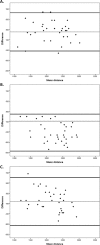The Yo-Yo intermittent recovery test level 1 is reliable in young high-level soccer players
- PMID: 25729152
- PMCID: PMC4314606
- DOI: 10.5604/20831862.1127284
The Yo-Yo intermittent recovery test level 1 is reliable in young high-level soccer players
Abstract
The aim of the study was to investigate test reliability of the Yo-Yo intermittent recovery test level 1 (YYIR1) in 36 high-level youth soccer players, aged between 13 and 18 years. Players were divided into three age groups (U15, U17 and U19) and completed three YYIR1 in three consecutive weeks. Pairwise comparisons were used to investigate test reliability (for distances and heart rate responses) using technical error (TE), coefficient of variation (CV), intra-class correlation (ICC) and limits of agreement (LOA) with Bland-Altman plots. The mean YYIR1 distances for the U15, U17 and U19 groups were 2024 ± 470 m, 2404 ± 347 m and 2547 ± 337 m, respectively. The results revealed that the TEs varied between 74 and 172 m, CVs between 3.0 and 7.5%, and ICCs between 0.87 and 0.95 across all age groups for the YYIR1 distance. For heart rate responses, the TEs varied between 1 and 6 bpm, CVs between 0.7 and 4.8%, and ICCs between 0.73 and 0.97. The small ratio LOA revealed that any two YYIR1 performances in one week will not differ by more than 9 to 28% due to measurement error. In summary, the YYIR1 performance and the physiological responses have proven to be highly reliable in a sample of Belgian high-level youth soccer players, aged between 13 and 18 years. The demonstrated high level of intermittent endurance capacity in all age groups may be used for comparison of other prospective young soccer players.
Keywords: aerobic capacity; football; reliability; talent identification; talent selection.
Figures
References
-
- Bangsbo J, Iaia FM, Krustrup P. The yo-yo intermittent recovery test: A useful tool in evaluation of physical performance in intermittent sports. Sports Med. 2008;38:37–51. - PubMed
-
- Krustrup P, Mohr M, Amstrup T, Rysgaard T, Johansen J, Steensberg A, Pedersen PK, Bangsbo J. The Yo-Yo Intermittent Recovery Test: Physiological response, reliability and validity. Med Sci Sports Exerc. 2003;35:697–705. - PubMed
-
- Deprez D, Coutts A, Lenoir M, Fransen J, Pion J, Philippaerts RM, Vaeyens R. Reliability and validity of the Yo-Yo intermittent recovery test level 1 in young soccer players. J Sports Sci. 2014;32:903–910. - PubMed
-
- Castagna C, Abt G, D’Ottavio S. Competitive-level differences in yo-yo intermittent recovery and twelve minute run test performance in soccer referees. J Strength Cond Res. 2005;19:805–809. - PubMed
-
- Souhail H, Castagna C, Mohamed HY, Younes H, Chamari K. Direct validity of the yo-yo intermittent recovery test in young team handball players. J Strength Cond Res. 2010;24:465–470. - PubMed
LinkOut - more resources
Full Text Sources
Other Literature Sources

